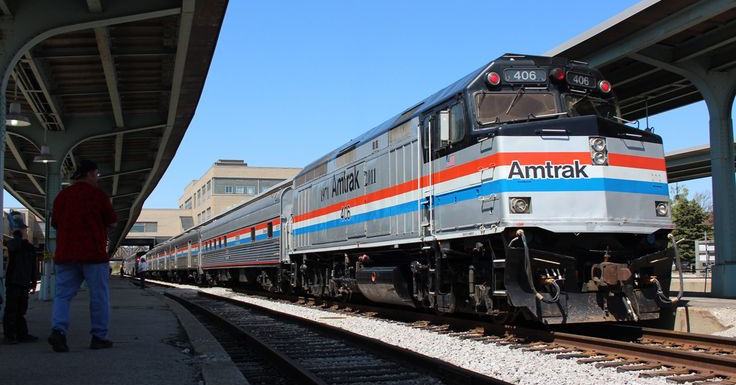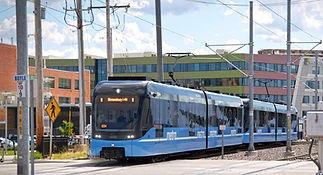New "All Aboard Act" Could Funnel Billions into Ohio Passenger Rail, But Major Hurdles Remain
A $200 billion federal bill could finally expand modern passenger rail across the nation. But major hurdles stand in the way of this transformative funding project for Passenger Rail

August 17, 2025
Ryan Pecaut
A proposed $200 billion federal investment, the "All Aboard Act," could fundamentally reshape travel across the nation, presenting a historic opportunity to build a modern passenger rail network including high-speed rail. The legislation, reintroduced in Congress by Rep. Chris Deluzio (D-PA) and Sen. Edward J. Markey (D-MA), offers a detailed blueprint for a faster, cleaner, and more connected American transportation system.
For Ohio, a state poised with ready-to-go rail plans, this bill could be a catalyst that transforms decades of advocacy into a reality of steel wheels on steel rails, connecting its major cities for the first time in a generation. However, the ambitious plan faces significant political and practical roadblocks on its journey to becoming law.

The $200 Billion Blueprint for American Rail
The All Aboard Act is more than just a funding bill; it's a comprehensive vision for the future of the country's rail infrastructure. It aims to create a system that is "safe, fast, and affordable" by strategically investing $200 billion over five years.
Here’s a detailed breakdown of where that money would go:
$80 Billion for New Corridors: This is the largest and most critical fund for Ohio. It's designed to help states build, expand, and improve intercity passenger rail routes. This money would be the primary source for constructing projects like Ohio's planned 3C+D corridor, which would link Cleveland, Columbus, Dayton, and Cincinnati.
$50 Billion for a "Green Railroad Fund": This new initiative is focused on climate and public health. It would fund the electrification of busy rail lines and highly-polluting railyards, aiming to replace diesel engines with cleaner electric technology.
$30 Billion Directly to Amtrak: This funding would go toward modernizing Amtrak's aging fleet of trains, renovating stations across the country, and bringing existing infrastructure into a state of good repair.

$10 Billion to Eliminate Rail Crossings: A targeted fund to improve safety at grade crossings, a necessary step for increasing train speeds and frequency.
$3.5 Billion for State Rail Planning: This provision would be a game-changer for states like Ohio. For the first time, it would create a formula-based program—similar to how federal highway funds are distributed—to give states a predictable, annual source of money for rail planning and maintenance like highways receive. This would end the current reliance on fierce, all-or-nothing competitive grant applications.
The bill is also strongly pro-labor, embedding protections for the existing union workforce and mandating two-person crews, a key safety priority for rail unions. This has earned it the powerful backing of major unions like the AFL-CIO and the Brotherhood of Locomotive Engineers and Trainmen (BLET).

Ohio's "Goldilocks Moment"
The All Aboard Act arrives at a uniquely opportune time for the Buckeye State. Unlike the failed "Ohio Hub" plan of 2010, which was rejected by the state government, today's strategy is seen as far more pragmatic and achievable.
Advocates call it the ultimate "Goldilocks" project: it avoids the astronomical costs and construction challenges of true high-speed rail by focusing on existing, freight-owned corridors for conventional-speed service, with trains running around 70mph.
This practical approach has already been validated by the federal government. In late 2023, the Federal Railroad Administration (FRA) formally accepted four Ohio routes into its Corridor ID program, the official pipeline for developing new passenger rail service. The key routes include:
The 3C+D Corridor: The state's top priority, connecting Ohio's four largest economic hubs and restoring service to Columbus, the biggest U.S. metro area without Amtrak.
Midwest Connect: An interstate route linking Chicago, Fort Wayne, Columbus, and Pittsburgh.
Cleveland-Toledo-Detroit: A northern corridor improving Ohio's connection to Michigan.
The economic case is compelling. A study by Scioto Analysis projected that just building the 3C+D line would create 1,100 jobs and add over $100 million to Ohio's economy. Once running, the route is expected to generate up to $47 million in annual economic impact and serve up to 500,000 riders a year. This potential has created a powerful, bipartisan coalition of cities, chambers of commerce, and planning organizations supporting the vision.

Reality Check: Navigating Major Obstacles
Despite the strong planning and broad support, the path forward is filled with challenges.
The bill's massive $200 billion price tag makes it a natural target for fiscal conservatives and taxpayer advocacy groups. The lingering shadow of the California High-Speed Rail project—a venture whose cost has ballooned from an initial $33 billion to over $100 billion amid delays and mismanagement—provides powerful ammunition for critics who label such projects as wasteful "boondoggles."
This skepticism is also present in Columbus. While the Ohio House recently voted to support passenger rail planning, the Ohio Senate removed the provision, signaling a lack of political consensus at the state level that could jeopardize the matching funds needed to secure federal grants.

Ryan Pecaut
Ryan Pecaut is the Communications Strategy Lead at All Aboard Ohio
ABOUT ALL ABOARD OHIO
All Aboard Ohio is a non-profit, member-based organization dedicated to promoting improved public transportation and passenger rail service throughout the state.
Founded in 1973 and incorporated as a registered 501c-3 in 1987, All Aboard Ohio has spent more than 50 years advocating, educating, and working towards our goal of a connected Midwest
All Aboard Ohio is a 501c-3 nonprofit with over 50 years of advocacy work, advocating for improved public transportation and passenger rail service in the Midwest
©2025 by All Aboard Ohio
Get in Touch
3136 Kingsdale Center,
#112 Columbus, OH 43221
Federal Tax ID: 31-1066182








